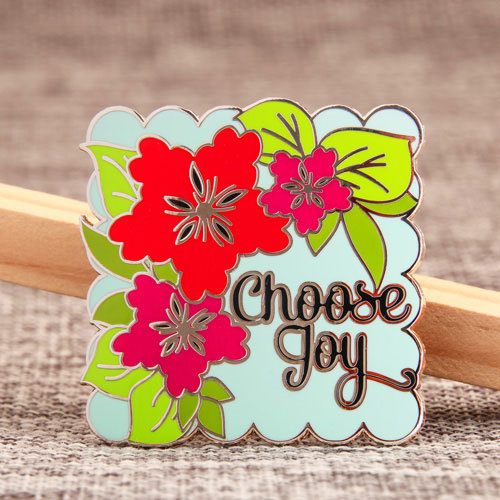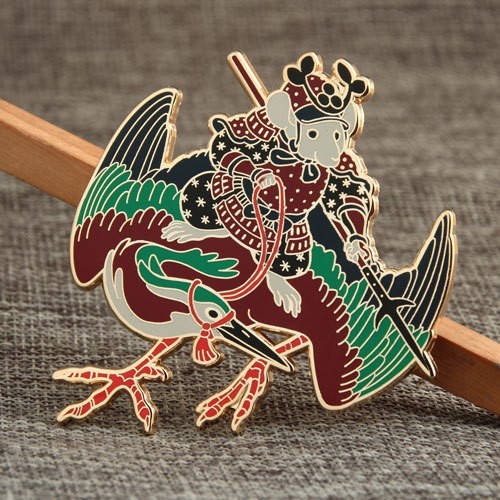There are a lot of options and choices when ordering lapel pins. It can seem overwhelming when trying to get the perfect pin to represent your vision, exactly the way you see it. You may have been given the dauting task of finding out how to make a company or event pin, with possibly very little time to get it done… Luckily you are in the right place! GS-JJ is a vertically integrated, factory-direct manufacturer. We offer the quickest production and delivery of real, traditionally handmade lapel pins. Our pins will last forever* and will be carrying your message for centuries to come.
Hard Enamel
Hard enamel is the original enameling process, started as a traditional Chinese art form for creating everyday items that were literal works of art. Everyday vases and pitchers, common drinkware, have lasted for thousands of years, and are now incredibly valuable. Hard enamel is also called cloisonné†, an ancient French word meaning “Partitioned”, you will probably see this term when researching and choosing options for your pin.
Hard enamel pins are great for company recognition, anniversaries, and commemorating important events like product launches. The color-fill is almost equal in height to the partition lines, giving the pin a tactile, jewelry-quality feeling which also works well for retail sales and professional sports organization applications. Hard enamel is also the choice of state and federal government agencies when choosing a pin for commemoration.
Miniature hand-made works of art
Hard enamel lapel pins are created by striking or forging a metal emblem with raised and recessed areas. The recessed areas are pools to accept color, and the raised metal lines form the “partitions” or traps, to separate the individual colors. The raised lines are plated, usually in gold or silver, creating the cloisonné effect. All pins require some type of tooling to start with. Die-struck pins (most common) require handmade tungsten dies, which are repeatedly forged and quenched until they reach a Rockwell-A hardness of 660. These handmade dies are inserted into a machine that strikes a brass or copper strip with over 10,000 psi of force, stamping down the areas that will receive color while leaving tiny partition lines to separate the enamels. A separate die is required to cut the freeform shape for the outside pin edge.

Cast pins require a double-sided mold, usually 4 -6 pins can be molded at once. The mold is clamped into an injection molding machine and filled at high pressure with molten zinc. Once the zinc cools, The mold is opened the edges of the pins are deburred, and the pins are plated in nickel and copper. From this point, die-struck or cast hard enamel pins are finished virtually identically.
Color-filling by hand is traditional
Traditional cloisonné coloring material is a powdered, ground glass, which along with coloring pigments and porcelain paste, are fired in ovens for long periods at high temperatures. The surface created is beautiful, deep and durable. The colors don’t fade, crack or peel, but traditional cloisonné is only available with 72 different colors and exact matching of many logo colors is not possible. Additionally, when using reds, whites, yellows and oranges, the edges closest to the metal may sometimes darken or burn. This edge burning is a hallmark of real cloisonné.

After firing the enamel and cooling, craftsmen polish each pin dozens of times with different grits of fine and ultrafine polishing wheels and buffing wheels. Then, each pin is given a deep bath in the electroplating finish of your choice. Once again, the pins are polished and buffed by hand until the enamel colors are bright and the metal plating is lustrous, deep, and perfect. During this process each pin is visually inspected many times over. Each pin is literally a tiny, handmade work of art.
Traditional history meets modern materials and eco-consciousness
Thankfully, in the last 5000 years, we’ve come up with a few ways to modernize this traditional process. We use less glass and our pigments are formed with modern inks that can be PMS®** matched extremely closely to almost any color. No more edge-burning, less grinding and polishing, and users were now able to more closely match their organization’s logo colors. We still polish and inspect each pin dozens of times, and each pin is still hand colored and hand finished. We are craftsmen at the highest level. We have a short, greatly condensed video of the entire hard enamel process Here.
On a final note, all real enamel comes from China. Die making, color mixing and the entire process has been handed down from masters to students for thousands of years. “Enameled” products made anywhere else are just painted with an enamel-based paint similar to model paint. Pins made in this way will not last like a traditionally made product. We directly own our factory and control our production 100%. You will always get the highest quality real hard enamel lapel pins from GS-JJ, with free, on-time delivery and no hidden fees.
Our next article will feature history and detailed information on Soft Enamel Lapel Pins. Thank you for reading! In the meantime, check out our Online Design System and design a hard enamel pin that suits your vision.
_________________________________________________________________ *-”Our pins will last forever” There are examples of hard enamel emblems over 5000 years old, 300 year old soft enamel emblems regularly sell at antique shows. If you make a pin today, it will still be around long after humans have colonized the galaxy. As long as you don’t run it over with a truck or hit it with a hammer, hard enamel pins have an infinite lifespan. **-PMS™ and Pantone Matching System™ are registered trademarks of Pantone LLC© , a wholly owned subsidiary of X-Rite, Incorporated. †- (Pronnounced Cloy-So-Nay) Chinese Cloisonné is a method of enamelling an object, (typically made of copper) whereby fine wires are used to delineate the decorative areas (cloisons in French, hence cloisonné) into which enamel paste is applied before the object is fired and polished. © Victoria and Albert Museum of Art and Design, London 2023
______________________________________________________________________________
Henry has over 25 years of experience designing, manufacturing, importing, and delivering enamel pins, challenge coins, medals and patches all around the world. He has worked directly with many major brands like FIFA™, Hot Topic©, KONAMI™, and the United States Air Force™ / United States Space Force™. Henry apologizes for getting overly-technical sometimes, he just LOVES pins and coins.
All images, descriptions, and copy are ©EnamelPins, Inc. 2023. For the rights to reproduce, link, or quote, please email us at info@gs-jj.com
